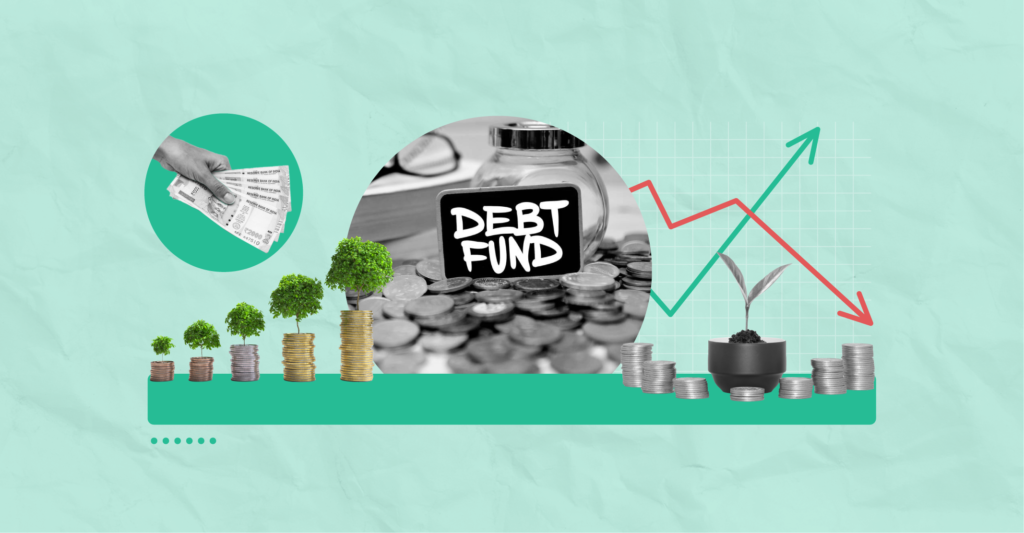Last Updated on May 3, 2023 by Anjali Chourasiya
Mutual funds, one of the oldest investment options, do not need an introduction. But there are different types of mutual funds that you need to be aware of. Debt funds are one of the mutual funds types, which invest in fixed-income instruments like government bonds, corporate bonds, bonds issued by banks, treasury bills, certificates of deposit, etc. Debt funds are considered an ideal investment for risk-averse investors. In this article, find the high-quality debt funds in India that may withstand a volatile market.
Table of Contents
List of high-quality debt funds
With a high inflation rate and several macroeconomic factors, the market is quite volatile these days. You can rebalance your investment portfolios during such turbulent times with the best debt mutual funds.
| Name | AUM (Rs. in cr.) | Average Maturity | Exit Load (in %) | % A Rated Bonds (in %) | % Cash Holding (in %) | Category YTM | 3Y Avg Annual Rolling Return (in %) |
| Aditya Birla SL Liquid Fund | 42,493.34 | 0.12 | 0.007 | 89.63 | 3.03 | 5.98 | 4.55 |
| Tata Liquid Fund | 14,144.426 | 0.10 | 0.007 | 75.50 | 4.78 | 5.98 | 4.52 |
| ICICI Pru Liquid Fund | 45,873.62 | 0.12 | 0.007 | 75.28 | 7.43 | 5.98 | 4.50 |
| UTI Liquid Cash Plan | 27,441.80 | 0.14 | 0.007 | 75.48 | 0.90 | 5.98 | 4.48 |
| HDFC Liquid Fund | 50,028.86 | 0.11 | 0.007 | 77 | 3.56 | 5.98 | 4.48 |
| DSP Liquidity Fund | 12,226.19 | 0.08 | 0.007 | 73.74 | 9.04 | 5.98 | 4.43 |
| Kotak Liquid Fund | 26,083.51 | 0.13 | 0.007 | 82.21 | 1.27 | 5.98 | 4.39 |
The above list of high-quality debt mutual funds are based on their 3-yr average rolling returns. The data mentioned is from 12th October 2022 and is filtered using Tickertape Pre-built Screener. Follow the steps below to get high-quality debt funds using Tickertape.
- Log in to the Tickertape website.
- Click on the Mutual Fund Screener page.
- On the Screener, click on ‘All Screens’. Then, under Premium, find ‘High-Quality Debt Portfolio’. The screener will load with the following parameters:
– Category: Debt funds
– Plan: Growth
– Assets Under Management (AUM): In debt funds, a company with a high AUM signifies that it is the most preferred one by the investors. However, there can be funds with low AUM but with good track records concerning risk and returns.
– % A-rated Bonds (in %): This is a metric relevant for debt mutual funds. It represents the portion of the portfolio invested into good credit quality bonds that include the following ratings: AAA, AA+, AA, AA-, A+, A, A-, A1-A4. In our case, this is set from 70% to 100%.
– % Cash Holdings (in %): This represents the portion of the portfolio invested into cash to either handle redemptions or to park the funds temporarily before a long-term allocation can be decided. In our case, this is set from 0-10%.
– Category Yield To Maturity (YTM) – It is the average Yield to Maturity (YTM) of all the funds within a category.
– Average Maturity
– Exit Load - You can also add more parameters by clicking on ‘Add Filters’ or remove the existing ones as well.
Note: The stocks are listed using Tickertape’s Pre-built Screener – High-Quality Debt Portfolio, which is built using a different set of parameters. This screener is available for our Pro users. Check Tickertape Pro plans now!
1. Aditya Birla SL Liquid Fund
This open-ended liquid scheme was launched by Aditya Birla Capital Mutual Funds on 16th June 1997. As of 31st August 2022, the AUM of Aditya Birla SL Liquid Fund is Rs. 42,493.34 cr. The current NAV as of 11 October 2022 is Rs. 348.77. The minimum investment in this fund is Rs. 500.
2. Tata Liquid Fund
This liquid fund was launched by Tata Mutual Fund house on 1st September 2004. As of 30th September 2022, the AUM of Tata Liquid Fund is Rs. 12,089.37 cr. The current NAV as of 12 October 2022 is Rs. 3,413.30. The minimum investment in this fund is Rs. 5,000.
3. ICICI Pru Liquid Fund
This liquid fund was launched by ICICI Prudential Mutual Fund house on 17th November 2005. As of 30 September 2022, the AUM of ICICI Pru Liquid Fund is Rs. 39,742.02 cr. The current NAV as of 12 October 2022 is Rs. 320.74. The minimum investment in this fund is Rs. 99.
4. UTI Liquid Cash Plan
This liquid fund was launched by UTI Mutual Fund house on 10th December 2003. As of 31 August 2022, the AUM of the UTI Liquid Cash Plan is Rs. 32,857.36 cr. The current NAV as of 12 October 2022 is Rs. 3,552.57. The minimum investment in this fund is Rs. 500.
5. HDFC Liquid Fund
This liquid fund was launched by HDFC Mutual Fund house on 17th October 2000. As of 31 August 2022, the AUM of HDFC Liquid Fund is Rs. 54,964.42 cr. The current NAV as of 12 October 2022 is Rs. 4,252.55. The minimum investment in this fund is Rs. 100.
6. DSP Liquidity Fund
This liquid fund was launched by DSP Mutual Fund house on 23rd November 2005. As of 30 September 2022, the AUM of DSP Liquidity Fund is Rs. 10,612.00 cr. The current NAV as of 12 October 2022 is Rs. 3,092.76. The minimum investment in this fund is Rs. 500.
7. Kotak Liquid Fund
This liquid fund was launched by Kotak Mahindra Mutual Fund house on 04th November 2003. As of 31 August 2022, the AUM of Kotak Liquid Fund is Rs. 31,211.78 cr. The current NAV as of 12 October 2022 is Rs. 4,382.33. The minimum investment in this fund is Rs. 500, and a SIP of Rs. 1,000.
How can debt funds help your investment portfolio?
Debt funds are considered low-risk investments (compared to equity funds) due to the way they are structured. Depending upon the scheme and investment strategy, they invest in a basket of fixed-income instruments. For example, in the case of a liquid fund scheme with a maturity of up to 91 days, the investment is made in the money market instruments of a similar maturity period. Whereas corporate bond funds invest a minimum of 80% in corporate bonds.
Basically, debt instruments have a fixed maturity period. After the maturity, the investor gets back the investment made along with interest earned on the fund (if any). Though debt mutual funds do not guarantee returns, the investor will get their investment in full right after maturity. Therefore, the investor will not lose the capital.
So when an investor has other high-risk investments like equities in their investment portfolio, having a low-risk option like debt funds will balance the portfolio during volatile markets as debt funds are not affected by the market volatility.
Risks involved in debt funds
Though debt mutual funds are considered low-risk investments (compared to equity funds), there are certain risks associated with them, as listed below.
- Credit risk – As the name suggests, debt mutual funds lend money to a company. When you lend money, there is always risk associated with credit repayment capability, which is nothing but credit risk. However, you can determine a company’s ability to pay back through a credit rating. Credit rating agencies give these ratings like ICRA, CRISIL, etc. The higher the rating, the higher the ability to pay you back.
- Interest rate risk – Bond prices and interest rates are inversely proportional. The bond price goes up whenever the interest rate falls and vice versa. Also, there is a risk associated with the maturity period of the fund. If you have invested long-term, the bond can undergo several interest rate fluctuations. Hence low duration debt funds are considered.
For example, if you have invested Rs. 25,000 in a bond with a maturity period of 10 yrs and interest of 10% p.a. This means every year you will get Rs. 2,500 until maturity. But if the regular interest rate falls to 7%, as bonds are offering high interest of 10%, the demand increases. In such cases, you need to spend more to buy the same quantity of the bond. But if the interest rate increases, the bond price can come down, giving you negative returns.
Equity fund vs debt fund
Equity funds and debt funds are two different types of mutual funds. Here’s a table of equity vs debt funds.
| Features | Debt mutual fund | Equity Mutual Fund |
| Investment | Invests in fixed-income instruments like government bonds, corporate bonds, bonds issued by banks, treasury bills, certificates of deposit etc. | Invests in equities or equity-related instruments. |
| Return on investment | Low to moderate when compared to equity funds. | High returns when compared to debt mutual funds in the long term. |
| Risk | Low to moderate risk. | Moderately high to high-risk. |
| Taxation | If the funds are held for less than 3 yrs, it is taxed as per the investor’s income tax slab. If the funds are held for more than 3 yrs, it is considered long-term capital gains and is taxed at 20% after allowing for indexation benefits. | Short-term capital gains (less than 12 months) from equity funds held for less than 12 months are taxed at 15%. Long-term capital gains (more than 12 months) of up to Rs. 1 lakh is tax exempt and more than Rs. 1 lakh is taxed at 10%. |
Debt fund vs FD
Here is the difference between debt funds and fixed deposits.
| Feature | Debt fund | Fixed Deposits (FD) |
| Investments | Invested in fixed-income securities. | Fixed interest at fixed tenure. |
| Risk | Low. | Nil. |
| Deposit frequency | Lumpsum or periodically. | Lumpsum. |
| Premature withdrawal | Exit load is charged. | Penalty is levied. |
Conclusion
Debt funds are considered a good option for risk-averse investors. These are less affected by market fluctuations and can offer moderate returns, which is good for a short-term investment.
FAQs
1. What is a debt fund?
Debt funds are a type of mutual fund. They primarily invest in fixed-income securities like government bonds, corporate bonds, bonds issued by banks, treasury bills, certificates of deposit, etc.
2. How do debt funds perform inflation?
Usually, as a measure to bring down inflation, RBI tends to hike the interest rate. And interest rates and bond prices are inversely proportional. When the interest rates are hiked, the demand for bonds falls, eventually reducing bond prices and vice versa. Inflation can help or hurt debt funds depending on the interest rate scenario.
3. What are the taxes levied on debt funds?
The returns (capital gains) on debt funds are taxable. The taxation on debt funds depends on the fund’s duration, which is as follows:
Short-Term Capital Gains (STCG) – Funds held for less than 3 yrs are taxed as per the tax slab of the investor.
Long-Term Capital Gains (LTCG) – Funds held for more than 3 yrs are taxed at 20% with indexation benefits. Indexation is recalculating the investment’s purchase price after adjusting it for the inflation index.
4. Do debt funds allow periodical payments?
Debt funds allow both periodical payments and lumpsum investments as well. You can start your debt fund investment with as little as Rs. 99.
- Top AI Stocks in India: Best Artificial Intelligence Companies on NSE (2025) - Mar 19, 2025
- Best Debt Mutual Funds in NSE India Based on 5Y CAGR - Mar 17, 2025
- List of Best Fundamentally Strong Stocks in India - Mar 13, 2025




